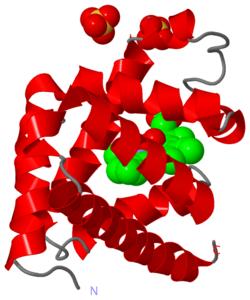JMS/sandbox15
From Proteopedia
(Difference between revisions)
| Line 22: | Line 22: | ||
'''Molecular Tour:''' | '''Molecular Tour:''' | ||
| - | The ability of an increase in number of positively charged regions to enable higher solubility is a known phenomenon | + | The ability of an increase in number of positively charged regions to enable higher solubility is a known phenomenon, and this study is consistent with previous reports. The aquatic animals have increased their number of positively charged regions through key substitutions of neutral amino acids for positively charged amino acids, and of negative amino acids for neutral or positive amino acids. We present one such manifestation of this overall trend, by comparing the elephant and whale myoglobin structures. |
Out of 27 divergent amino acids between whale and elephant's myoglobin - from a total of 153 amino acids - only 8 of these amino acids lead to changes of charge. These eight amino acids are shown for whales and elephants, <scene name='57/575026/Electrostatics/22'>side by side</scene>. Arginine and Lysine have a charge of +1, aspartic and glutamic acids have charges of -1, and histidine in positions 12 and 116 have a charge of about +0.5 (supplementary Table S2 <ref name="whaleMyo" />). The whale amino acids, have an illustrative eletrostatic field drawn around the <scene name='57/575026/Electrostatics/23'>electrically charged atom</scene> in the residue. Note that the effective size of the electric field of the charged atom at the end of residues like lysine is actually larger, because of the multiple conformations a long residue like lysine moves between. Next to the whale amino acid, the <scene name='57/575026/Electrostatics/18'>elephant residues</scene> are shown in yellow halos and labelled with the residue name. From studying the differences between these two proteins, it is clear that the whale protein has more areas with a positive electrostatic field. These positive electrostatic fields are <scene name='57/575026/Electrostatics/19'>scattered about the surface</scene> of the whale protein, and will repel any whale myoglobin, preventing the protein-protein interactions that lead to aggregation. | Out of 27 divergent amino acids between whale and elephant's myoglobin - from a total of 153 amino acids - only 8 of these amino acids lead to changes of charge. These eight amino acids are shown for whales and elephants, <scene name='57/575026/Electrostatics/22'>side by side</scene>. Arginine and Lysine have a charge of +1, aspartic and glutamic acids have charges of -1, and histidine in positions 12 and 116 have a charge of about +0.5 (supplementary Table S2 <ref name="whaleMyo" />). The whale amino acids, have an illustrative eletrostatic field drawn around the <scene name='57/575026/Electrostatics/23'>electrically charged atom</scene> in the residue. Note that the effective size of the electric field of the charged atom at the end of residues like lysine is actually larger, because of the multiple conformations a long residue like lysine moves between. Next to the whale amino acid, the <scene name='57/575026/Electrostatics/18'>elephant residues</scene> are shown in yellow halos and labelled with the residue name. From studying the differences between these two proteins, it is clear that the whale protein has more areas with a positive electrostatic field. These positive electrostatic fields are <scene name='57/575026/Electrostatics/19'>scattered about the surface</scene> of the whale protein, and will repel any whale myoglobin, preventing the protein-protein interactions that lead to aggregation. | ||
Current revision
| |||||||||||
References:
- ↑ 1.0 1.1 Mirceta S, Signore AV, Burns JM, Cossins AR, Campbell KL, Berenbrink M. Evolution of mammalian diving capacity traced by myoglobin net surface charge. Science. 2013 Jun 14;340(6138):1234192. doi: 10.1126/science.1234192. PMID:23766330 doi:http://dx.doi.org/10.1126/science.1234192
- ↑ https://pdb101.rcsb.org/motm/1#:~:text=PDB%2D101%3A%20Molecule%20of%20the%20Month%3A%20Myoglobin.

